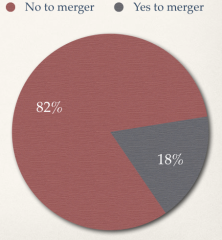 Recent research conducted by Local Government NSW shows 82% of Sydney metropolitan residents are opposed to their council merging.
Recent research conducted by Local Government NSW shows 82% of Sydney metropolitan residents are opposed to their council merging.
The main reason for this opposition is we know mergers will kill our local voice. And this voice is so important in making our communities more liveable, beautiful and healthy. It just makes sense.
This voice is also key in planning for Sydney. Yet, mistakenly the Independent Local Government Review Panel (ILGRP) see mergers, with fewer councils to deal with, as a way of make planning easier.
The whole “Fit for the Future” process seems not to understand that the local voice is THE main key to best planning practices and making councils fitter. Instead, it seems to deem this voice as insignificant or, worse, a nuisance.
Paradoxically, if the NSW State Government was to force mergers it would not be listening to this voice.
ILGRP is wrong. Mergers don’t = better planning
The Chair of the ILGRP, Professor Graham Sansom comments in his IPART submission that most metropolitan councils ARE financially fit and this is NOT the reason the ILGRP wants councils to merge. This fitness is backed up by recent analysis into the finances of metropolitan councils.
“Whilst some metropolitan councils need to improve various aspects of their financial performance, the revenue base available to them is generally more than sufficient for this to be achieved within their current boundaries.
Similarly, the great majority have considerable scope to improve efficiency where necessary through changes to their own operations or through cooperation with others,” Sanson says.
The ILGRP want council mergers primarily because it, wrongly, believes it will make planning and infrastructure-delivery easier for the NSW State Government.
“In the case of the Sydney region, the Central Coast and the Lower Hunter the ILGRP was firmly of the view that wide‐ranging council mergers were essential as part of a broader agenda to improve metropolitan governance, planning and management,” he adds.
The problem with ILGRP’s argument is that by amalgamating councils to become bigger and “easier” government units to deal with, we are in danger of losing Sydney’s biggest asset when it comes to planning – the input from the people.
Mergers will kill our greatest asset – the People’s voice
Evidence shows that smaller councils between the size of 40,000 and 71,000 residents are the “fittest”.
Smaller councils have more Councillors per head of population. Councillors from smaller councils are more likely to be locals with no outside or political vested-interests.
This makes them more likely to better gather people’s ideas, wants and needs for local areas. This in-turn allows them to spend better on what is really needed, just one of the many factors which make smaller councils stronger financially too.
Here in Pittwater we have first-hand experience of how much better it is to be smaller rather than larger. Twenty-four years ago we were part of Warringah Shire. On May 1, 1992 we split to form the smaller Pittwater Council and we haven’t looked back.
Best planning practices from around the world search for ways to better canvas the local voice. It is the key to making places more liveable and happier places to be. Places such as:
- City of Copenhagen
- City of Melbourne
- City of Tokyo
- City of Vancouver
- City of Vienna
- and it is good to see City of Sydney rising in the ranks
The one thing all these cities have in common is they all asked the people what they want – using this voice as an asset. All of them have used the same consultant, Jan Gehl in helping them to design and plan, including the City of Sydney.
Gehl’s philosophy is to build on a human-scale – to design and plan for people. Sounds obvious but this is actually what we haven’t done in the West (especially the USA, Canada and Australia).
When you listen to the people, according to planners who have done so, you eliminate many planning headaches and actually make the planning process easier with better outcomes.
This planning method can and should be used for local planning in our suburbs too. In fact Pittwater Council has just started using it for re-planning Mona Vale and Ingleside. It can also be used in planning the whole Sydney basin and NSW by better using our existing structure of local councils.
Conclusion – No need for expensive re-structure
The NSW Government can use the existing structure to gain what it needs PLUS ensure people retain their local voice – an asset important to everyone. It can do this via the six umbrella subregions as outlined in the Sydney Commission’s Plan.
The NSW Government has no need to turn local councils upside-down through painful, expensive, destructive, soul-destroying and election-losing council amalgamations to reach its goals.
Use what you have and use it now – the power of the people, the power of the existing councils.

When the elected Government lose touch with the people they were elected to serve… it’s time they moved on. Make decision based on the broader communities best interests not their POLITICAL best interests.
LikeLike